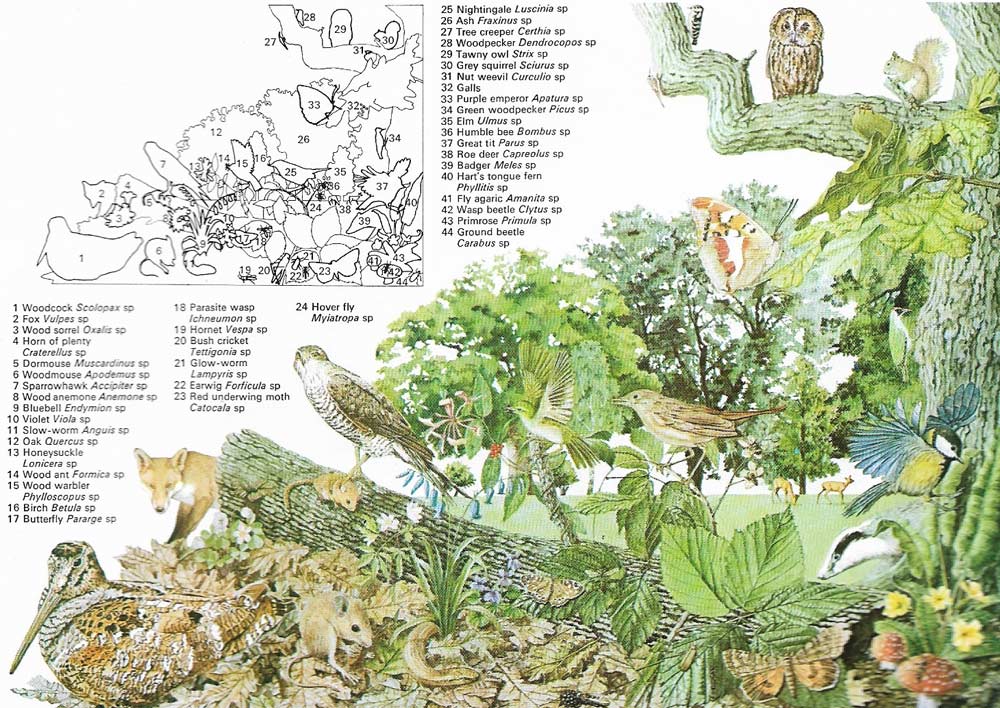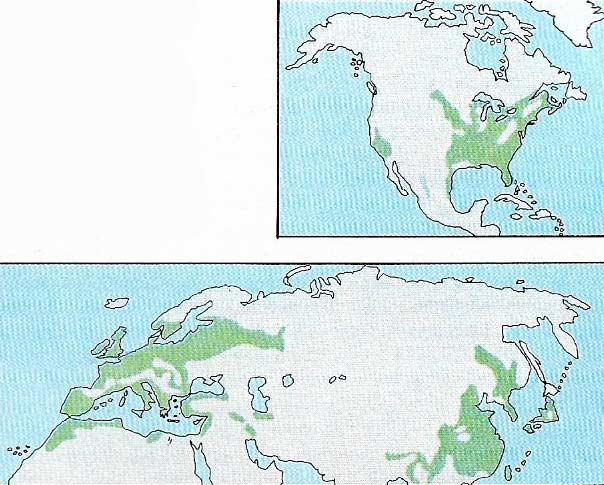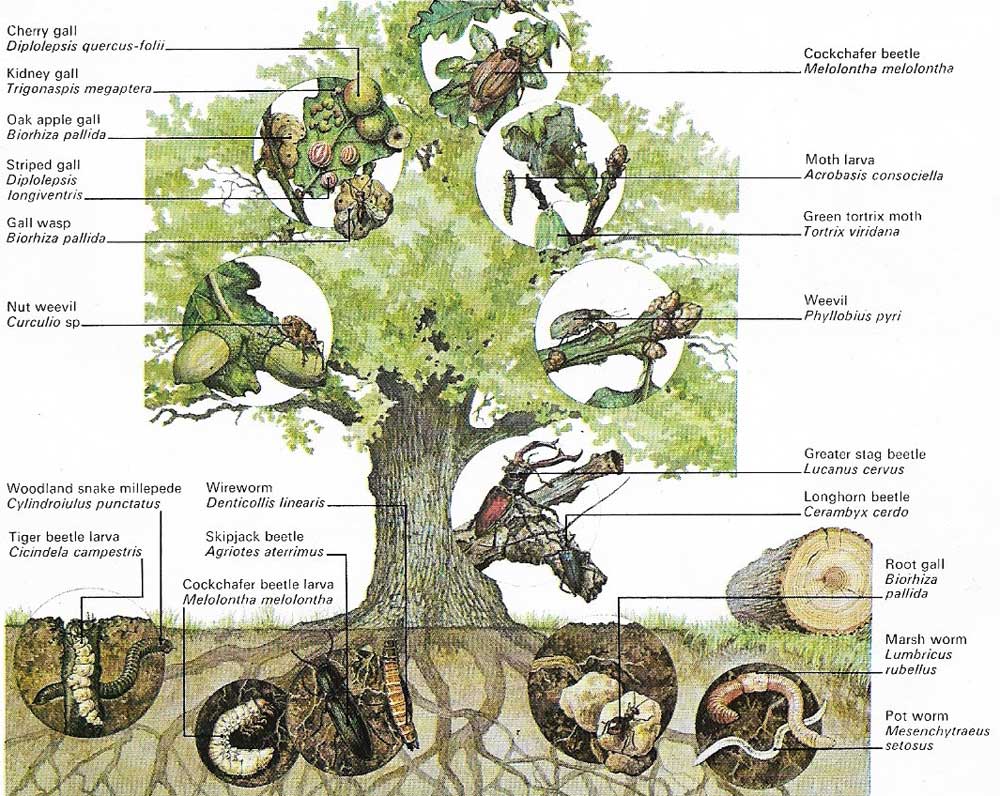northern temperate woodlands

An oak tree supports a wealth of small animal life. In the spring swarms of caterpillars, bugs, and beetles feed on the new leaves but do little lasting harm because the oak offsets the loss by putting out a late growth known as "lammas leaves". For some beetles the oak offers safety to their young. Larvae of the weevil Phyllobius live in twigs, those of the stag beetle in dead wood, and the nut weevil in acorns. Other species of larvae find safety in galls, the abnormal growths on a tree, which form where the minute grubs feed. In the soil beneath the tree a variety of worms break down fallen leaves and litter. Millipedes, worms, and larvae feed on soft, rotting plants and roots. The voracious larva of the tiger beetle digs a deep hole in which to hide and catch unwary insects, while the colorful adult beetle hunts small forest invertebrates.

Figure 1. Forest is the natural ground cover wherever there is sufficient moisture in the temperate regions. In North America, only remnants are left of the great temperate deciduous forests that once covered much of the eastern half of the continent. The temperate mixed woodlands of Europe extend from the British Isles across central Europe into Russia. Beyond the Tibetan mountains are further areas of deciduous forest in eastern China. Oak, ash, beech, and chestnut are typical trees of Europe's forests. Vast areas are being cleared for urban and agricultural development and in places the natural growth is being replaced with faster-growing conifers.

Figure 2. The trees of an English oak wood provide nourishment and shelter for many species of wildlife. Some species are primarily dependent on the trees for their food, while others are predators, finding their food among the herbivores. In its natural state, a broad-leaved woodland usually contains mixed plant species. If the soil is acid, birches are often present; where it is alkaline, ash trees and ferns can often be found. Elm usually grows in hedgerows or at the edge of a wood for it spreads by suckering, not seeds. Among the smaller plants, the woody honeysuckle is supported by other trees. The spring-flowering herbs include primroses, violets, wood anemones, wood sorrel, and bluebells. Two common large fungi present are horn of plenty and fly agaric. Of the woodland mammals only the dormouse and wood mouse are confined to the forest. Foxes, badgers, deer, and squirrels use it as a source of food and shelter. The grey squirrel, an introduced species from America, has largely replaced the native red squirrel in Britain, but is not present in the rest of Europe. Woodland birds include the ground-dwelling woodcock, rarely seen because of its camouflaged coloring and shy ways. The great tit is a resident, while the wood warbler and nightingale are migrants, taking advantage if the summer wealth of insects. The tree creeper searches the bark for small insects but the woodpeckers feed on grubs extracted with their long bills. Birds of prey are the day-hunting sparrow-hawk and the nocturnal tawny owl, which feed on small mammals and other birds. Many of the insects have short adult lives and can be seen for only a few weeks in the breeding season.

Figure 3. The forest floor, with its fallen leaves and debris, supports a different micro-community from that of growing trees. Hosts of small, often microscopic creatures are constantly active in breaking down the dead tissues of the forest litter and returning the components to the soil for use by the plants. Tiny insects bore into the tissues, preceding the many fungi, bacteria, and other invaders that continue the process until the breakdown is completed. These organisms can be extremely specialized. In most cases they require a particular species of plant or tree, which will be tackled only when it is in a particular state of dryness or humidity. Many tiny creatures are the prey of hunters such as beetles and the slimy salamanders; the bigger kinds may be taken by birds and forest mammals. Foxes and badgers, for instance, will often eat worms and grubs when hungry.
Broadland forests, consisting of a mixture of deciduous tree species, are characteristic of much of the temperate zone of the Northern Hemisphere (Figure 1). In the past, forests of this sort were probably greater in extent, but they have been reduced in area by climatic changes and human activities in creating more agricultural land.
Remnants of the former grandeur of the temperate woodlands can still be seen in China and North America. In forests there several plant species survive that are otherwise known only as fossils or cultivated species in Europe and western Asia. They include the dawn redwood (Metasequoia glyptostroboides), a deciduous conifer, and the maidenhair tree (Ginkgo biloba), both from China, and the tulip tree (Liriodendron tulipifera) from North America.
Man's activities in the forests have been almost entirely destructive. Over most of western Europe, for example, little of the original woodland remains. Many of the trees that do exist there have been planted, human-managed, or destroyed completely to make way for farmland. Whenever once forested land is abandoned in western Europe it is quickly covered by scrub. If this were left, a succession of trees would gradually become dominant until, after two or three centuries, a completely new forest would arise.
The woodland community
The trees in temperate forests are generally smaller than those of tropical forests, but all the major plant groups are represented among the many species found in the northern woodlands. The trees themselves are dominant but there are other woody species, such as the honeysuckle and ivy, supported by the trees; and where there is enough light, there may nay be an undergrowth of hazel and hawthorn or other smaller trees, Below this is a ground layer of herbaceous plants that must complete their life cycle in the spring months due to the lack of light once the trees and underwood are in full leaf. When light and warmth increase in the early part of the year these plants, including snowdrops, primroses, and bluebells, flower in rapid succession.
Most trees also flower in springtime, bearing catkins whose pollen is spread by the wind and would thus be impeded by leaves. The relatively few exceptions, particularly some of the more southerly woodland species such as limes and chestnuts, are insect-pollinated and flower later. Many kinds of lower plants and often abundant in forests. Fungi come into their own as the trees die for there function is largely that of recycling agents; they break down the woody tissues and return them to the soil.
Animals of the woodlands
Animals in temperate woodlands are mostly small. The largest European animals,the aurochs (Bos primigenius), wild oxen, became extinct in the seventeenth century and only a small number of European bison (Bison bonasus) survive in the eastern forests of the continent. In North America the wood bison (Bison bison) has been reduced in numbers by man and deer are now the largest creatures of most temperate woodlands. The biggest of these, the elk (Alces alces), is found in the more northern forest areas in Europe although it is more common in North America, where it is known as the moose.
The paucity of large animals in the northern forests does not mean that the forests lack animal life, but rather that its richness depends on specialization, which is better achieved by small creatures. The common oak (Quercus robur) is said to support more than 300 animal species (top illustration). Some of these, such as squirrels, depend partly on other plants. But many small animals are tied both to one kind of tree as well as to a particular part of it – a leaf, twig, or root – for their specialized existence. At all levels, from the canopy to the ground, there is a web of interdependent species (Fig 2).
The yearly food cycle
With the springtime growth of the plants there is a resurgence among the animals. Many small creatures emerge from hibernation to feed on the new leaves and to become themselves predators. These predators include invertebrates, small birds and various insectivorous mammals.
Later in the year the first flush of animal and plant life disappears, but at not time are the woods empty of animal life. Even in winter grubs continue to bore their tunnels through the trunks of the trees. When a tree dies it still supports a host of organisms, such as fungi, ants, and beetles, whose task is to assist in the speedy breakdown of the wood so that the soil is not impoverished by the loss of a tree. There are always small creatures, especially worms, at work in leaf litter on the forest floor, converting the autumn leaf fall into humus in the soil.
The trees influence life far beyond their own boundaries. Their need for water draws it from as far as their roots will reach. It is taken through the woody tissues and finally much of it is lost to the atmosphere via the leaves. A single large tree will, during spring and summer, pass hundreds of liters of water to the atmosphere in a day. The forest thus bypasses the normal slow route of water through the soil to watercourses and then to the sea, from where it is evaporated to form clouds from which rain falls again.


